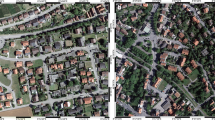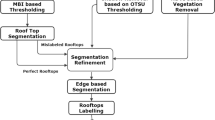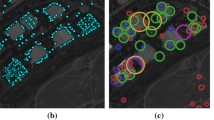Abstract
Identifying and extracting urban features such as buildings and producing accurate information about the location of features from remotely sensed images is important in updating maps, spatial databases, urban planning, and meeting the needs of urban services. Supervised methods of producing training data were widely applied in deriving accurate information from such images. However, those approaches require human intervention and are therefore time-consuming, and associated with classification accuracy limitations. This study presents a novel approach for extracting buildings from remotely sensed images by automating training data selection steps for supervised classification. To prepare training samples intelligently and automatically, a knowledge-based integration of radar and optical images was used. First, a general height constraint was applied to a digital surface model (DSM) obtained from radar images to divide the image pixels into two parts. Then, by applying a local height filter in each part, pixels representing buildings were extracted. Considering that the buildings are not the only features with significant heights, another constraint defined as coherence constraint was considered. Then, histogram of the optical image pixels corresponding to the filtered radar DSM pixels extracted from the previous steps was used to select sample training pixels. By considering pixels within the maximum range of the histogram, the final building samples for Support Vector Machine (SVM) classification were derived and applied for building extraction. The output showed that it sufficiently and reliably improved the existing supervised classification limitation to extract building. The performance of the proposed method was evaluated over different image datasets regardless of input image type and region. It achieved an overall average accuracy of 92% and a kappa coefficient of 0.83.













Similar content being viewed by others
Data availability
The datasets generated during and/or analyzed during the current study are available from the corresponding author on reasonable request.
References
Adam E, Mutanga O, Odindi J, Abdel-Rahman EM (2014) Land-use/cover classification in a heterogeneous coastal landscape using RapidEye imagery: evaluating the performance of random forest and support vector machines classifiers. Int J Remote Sens 35(10):3440–58
Amarsaikhan D, Blotevogel H, Van Genderen J, Ganzorig M, Gantuya R, Nergui B (2010) Fusing high-resolution SAR and optical imagery for improved urban land cover study and classification. Int J Image Data Fusion 1(1):83–97
Amory AA, Rokabi AO, El Zaart A, Mathkour H, Sammouda R (2012) Fast optimal thresholding based on between-class variance using mixture of log-normal distribution. In: 2012 International Conference on Information Technology and e-Services. IEEE, pp. 1–4
Attarzadeh R, Momeni M (2018) Object-based rule sets and its transferability for building extraction from high resolution satellite imagery. J Indian Soc Remote Sens 46(2):169–178
Benediktsson JA, Pesaresi M, Amason K (2003) Classification and feature extraction for remote sensing images from urban areas based on morphological transformations. IEEE Trans Geosci Remote Sens 41(9):1940–1949
Bennett AJ, Blacknell D (2003) The extraction of building dimensions from high resolution SAR imagery. In: 2003 Proceedings of the International Conference on Radar (IEEE Cat. No. 03EX695), IEEE, pp. 182–187
Bruzzone L, Carlin L (2006) A multilevel context-based system for classification of very high spatial resolution images. IEEE Trans Geosci Remote Sens 44(9):2587–2600
Cai H, Wang Y, Lin Y, Li S, Wang M, Teng F (2022) Systematic comparison of objects classification methods based on als and optical remote sensing images in urban areas. Electronics 11(19):3041
Chabalala Y, Adam E, Ali KA (2022) Machine learning classification of fused Sentinel-1 and Sentinel-2 image data towards mapping fruit plantations in highly heterogenous landscapes. Remote Sens 14(11):2621
Chaudhuri D, Kushwaha NK, Samal A, Agarwal R (2015) Automatic building detection from high-resolution satellite images based on morphology and internal gray variance. IEEE J Sel Topics Appl Earth Observat Remote Sens 9(5):1767–1779
Cho K, Park S-E, Cho J-H, Moon H, Han S-H (2020) Automatic Urban Area Extraction From SAR Image Based on Morphological Operator. IEEE Geosci Remote Sens Lett 18(5):831–835
Dutta A, Sarma KK (2014) SAR image segmentation using wavelets and Gaussian mixture model. In: 2014 International Conference on Signal Processing and Integrated Networks (SPIN), IEEE, pp. 466–770
Farhadi H, Managhebi T, Ebadi H (2022) Buildings extraction in urban areas based on the radar and optical time series data using Google Earth Engine. Sci-Res Q Geogr Data (SEPEHR) 30(120):43–63
Ghassemian H (2016) A review of remote sensing image fusion methods. Inf Fusion 32:75–89
Ghosh A, Joshi PK (2014) A comparison of selected classification algorithms for mapping bamboo patches in lower Gangetic plains using very high resolution WorldView 2 imagery. Int J Appl Earth Obs Geoinf 26:298–311
Gualtieri JA, Cromp RF (1999) Support vector machines for hyperspectral remote sensing classification. In: 27th AIPR Workshop: Advances in Computer-Assisted Recognition, vol 3584. SPIE, pp 221–232
Hackman KO, Gong P, Wang J (2017) New land-cover maps of Ghana for 2015 using Landsat 8 and three popular classifiers for biodiversity assessment. Int J Remote Sens 38(14):4008–4021
He W, Hellwich O (2009) Bayesian Building Extraction from high resolution polarimetric SAR data. In: 2009 IEEE International Geoscience and Remote Sensing Symposium, IEEE, vol. 4, pp. IV-402-IV-405
Heung B, Ho HC, Zhang J, Knudby A, Bulmer CE, Schmidt MG (2016) An overview and comparison of machine-learning techniques for classification purposes in digital soil mapping. Geoderma 265:62–77
Huang X, Yuan W, Li J, Zhang L (2016) A new building extraction postprocessing framework for high-spatial-resolution remote-sensing imagery. IEEE J Sel Top Appl Earth Obs Remote Sens 10(2):654–668
Huertas A, Nevatia R (1988) Detecting buildings in aerial images. Comput Vision Graph Image Process 41(2):131–152
Inglada J (2007) Automatic recognition of man-made objects in high resolution optical remote sensing images by SVM classification of geometric image features. ISPRS J Photogramm Remote Sens 62(3):236–248
Jiao J, Deng Z (2016) Individual building rooftop and tree crown segmentation from high-resolution urban aerial optical images. J Sens 2016:1–13. https://doi.org/10.1155/2016/1795205
Jin X, Davis CH (2005) Automated building extraction from high-resolution satellite imagery in urban areas using structural, contextual, and spectral information. EURASIP J Adv Signal Process 2005(14):1–11
Kanopoulos N, Vasanthavada N, Baker RL (1988) Design of an image edge detection filter using the Sobel operator. IEEE J Solid-State Circuits 23(2):358–367
Karan SK, Samadder SR (2018) A comparison of different land-use classification techniques for accurate monitoring of degraded coal-mining areas. Environ Earth Sci 77(20):713
Kumar A, Pandey AC, Jeyaseelan A (2012) Built-up and vegetation extraction and density mapping using WorldView-II. Geocarto Int 27(7):557–568
Lee DS, Shan J, Bethel JS (2003) Class-guided building extraction from Ikonos imagery. Photogramm Eng Remote Sens 69(2):143–150
Lizarazo I (2008) SVM-based segmentation and classification of remotely sensed data. Int J Remote Sens 29(24):7277–7283
Lodha SK, Kreps EJ, Helmbold DP, Fitzpatrick D (2006) Aerial LiDAR data classification using support vector machines (SVM). In: Third international symposium on 3D data processing, visualization, and transmission (3DPVT'06). IEEE, pp 567–574
Long T, Hu C, Ding Z, Dong X, Tian W, Zeng T, Long T, Hu C, Ding Z, Dong X, Tian W (2018) Algorithms for GEO SAR imaging processing. Geosynchronous SAR: System and Signal Processing, pp.77–128
Mather P, Tso B (2016) Classification methods for remotely sensed data. CRC Press, Boca Raton, FL
Nuthammachot N, Stratoulias D (2019) Fusion of Sentinel-1A and Landsat-8 images for improving land use/land cover classification in Songkla province, Thailand. Appl Ecol Environ Res 17(2):3123–3135
Peng J, Liu Y (2005) Model and context-driven building extraction in dense urban aerial images. Int J Remote Sens 26(7):1289–1307
Prajapati GL, Patle A (2010) On performing classification using SVM with radial basis and polynomial kernel functions. In: 2010 3rd International Conference on Emerging Trends in Engineering and Technology, IEEE, pp. 512–515
Rostami O, Kaveh M (2021) Optimal feature selection for SAR image classification using biogeography-based optimization (BBO), artificial bee colony (ABC) and support vector machine (SVM): a combined approach of optimization and machine learning. Comput Geosci 25(3):911–930
Senaras C, Vural FTY (2015) A self-supervised decision fusion framework for building detection. IEEE J Sel Top Appl Earth Obs Remote Sens 9(5):1780–1791
Shahzad M, Maurer M, Fraundorfer F, Wang Y, Zhu XX (2018) Buildings detection in VHR SAR images using fully convolution neural networks. IEEE Trans Geosci Remote Sens 57(2):1100–1116
Su W et al (2008) Textural and local spatial statistics for the object-oriented classification of urban areas using high resolution imagery. Int J Remote Sens 29(11):3105–3117
Teimouri M, Mokhtarzade M, Valadan Zoej MJ (2016) Optimal fusion of optical and SAR high-resolution images for semiautomatic building detection. Giscience Remote Sens 53(1):45–62
Tison C, Nicolas J-M, Tupin F, Maître H (2004) A new statistical model for Markovian classification of urban areas in high-resolution SAR images. IEEE Trans Geosci Remote Sens 42(10):2046–2057
Turker M, Koc-San D (2015) Building extraction from high-resolution optical spaceborne images using the integration of support vector machine (SVM) classification, Hough transformation and perceptual grouping. Int J Appl Earth Obs Geoinf 34:58–69
Wang Y, Li S, Teng F, Lin Y, Wang M, Cai H (2022) Improved mask R-CNN for rural building roof type recognition from uav high-resolution images: a case study in hunan province, China. Remote Sens 14(2):265
Wegner JD, Hänsch R, Thiele A, Soergel U (2010) Building detection from one orthophoto and high-resolution InSAR data using conditional random fields. IEEE J Sel Topics Appl Earth Obs Remote Sens 4(1):83–91
Xu Z, Wang R, Zhang H, Li N, Zhang L (2017) Building extraction from high-resolution SAR imagery based on deep neural networks. Remote Sens Lett 8(9):888–896
Yanjie Z, Prinet V (2004) InSAR coherence estimation. In IGARSS 2004. 2004 IEEE International Geoscience and Remote Sensing Symposium, IEEE, vol. 5, pp. 3353–3355
Yao W, Marmanis D, Datcu M (2017) Semantic segmentation using deep neural networks for SAR and optical image Pairs. In: Proc big data from space, pp 2–5
Zhao L, Zhou X, Kuang G (2013a) Building detection from urban SAR image using building characteristics and contextual information. EURASIP J Adv Signal Process 2013(1):1–16
Zhao L, Zhou X, Kuang G (2013b) Building detection from urban SAR image using building characteristics and contextual information. EURASIP J Adv Signal Process 2013:1–16
Funding
Also, the authors did not receive support or funding from any organization for the submitted work.
Author information
Authors and Affiliations
Contributions
Farshid Farnood Ahmadi, Rana Naanjam and Asra Salimi wrote the main manuscript text and prepared figures. All authors reviewed the manuscript.
Corresponding author
Ethics declarations
Competing interests
The authors do not have real or potential conflicts of interest to disclose.
Additional information
Communicated by H. Babaie.
Publisher's Note
Springer Nature remains neutral with regard to jurisdictional claims in published maps and institutional affiliations.
Rights and permissions
Springer Nature or its licensor (e.g. a society or other partner) holds exclusive rights to this article under a publishing agreement with the author(s) or other rightsholder(s); author self-archiving of the accepted manuscript version of this article is solely governed by the terms of such publishing agreement and applicable law.
About this article
Cite this article
Farnood Ahmadi, F., Naanjam, R. & Salimi, A. Developing an automatic training technique based on integration of radar and optical remotely sensed images for building extraction. Earth Sci Inform 17, 131–143 (2024). https://doi.org/10.1007/s12145-023-01154-w
Received:
Accepted:
Published:
Issue Date:
DOI: https://doi.org/10.1007/s12145-023-01154-w




